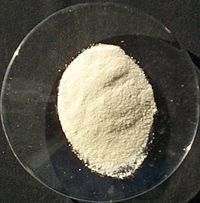
Photo from wikipedia
The photocatalytic generation of hydrogen via solar energy using metal oxide semiconductor catalysts is a clean and renewable process which has the potential of solving the current energy nexus. SnO2… Click to show full abstract
The photocatalytic generation of hydrogen via solar energy using metal oxide semiconductor catalysts is a clean and renewable process which has the potential of solving the current energy nexus. SnO2 is one such well-studied and established photocatalyst currently in practice but is only ultraviolet-light active which accounts for only 4% of the total incoming solar energy. The current study focuses on bringing this SnO2 into the visible range using ceria as a dopant. Sol–gel and combustion methods were employed for synthesis and the as-synthesized catalysts were characterized using XRD, BET, UV diffuse reflectance spectra, PL spectra, and SEM micrographs. A unique cuboid type morphology was observed in 6% ceria-doped SnO2 which provided more active sites for light absorption and thus reported a remarkable hydrogen production rate of 1.978 mmol/h under sunlight which was almost 346 times that of pure SnO2 (5.71 µmol/h). Photoluminescence spectra of ceria-doped SnO2 showed lower peak positions as compared to the pure SnO2 indicating a reduction in charge recombination and an increase in the life time of the active species which explains the enhanced hydrogen production rates. The recyclability study of the catalysts showed that the hydrogen amount produced in the fifth recycle was nearly 80% as the first cycle showing that the catalyst can be used very effectively for more than five cycles without compromising on the yield.
Journal Title: Environmental Science and Pollution Research
Year Published: 2022
Link to full text (if available)
Share on Social Media: Sign Up to like & get
recommendations!